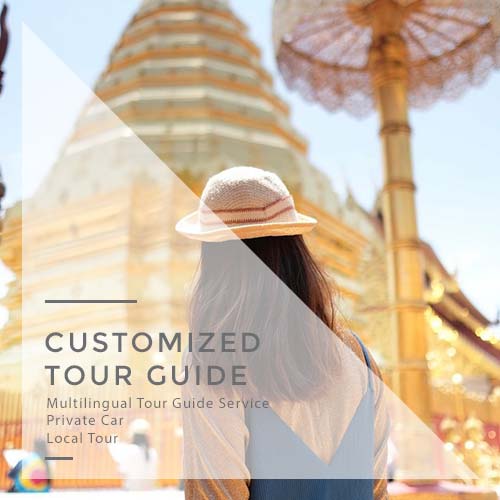21 Must-See Cultural & Historical Sites in Chiang Mai Old City
21 Must-See Cultural & Historical Sites in Chiang Mai Old City
Chiang Mai’s Old City is a treasure trove of cultural and historical sites, all waiting to be explored. From ancient temples with intricate carvings to charming old houses, every corner reveals a piece of history.
Forget expensive tours and packed schedules. Here, the best way to experience its rich heritage is simply to wander its streets at your own pace – the city itself becomes your museum, waiting to be unraveled.
Chiang Mai Old City (or the Old Town), surrounded by walls and moat, is the oldest and most interesting part of the city. It’s the center of Chiang Mai’s history and culture, located right in the middle of the whole city.
The Old City’s compactness makes it a walker’s paradise. Since everything is close together, you can reach countless fascinating sites without needing any transportation. And even if your walking tour leaves you a little weary, there’s always a delightful little cafe tucked around a corner, ready to offer a welcoming rest stop.

Dedicate a few mornings or evenings during your visit to Chiang Mai to lose yourself in this captivating maze. Walk slowly, taking in the sights and sounds around you.

Chiang Mai Old City is the heart of Chiang Mai. It’s easy to find on a map because it has a square shape, almost like a perfect box.
This itinerary allows you to explore Chiang Mai Old City’s many attractions at your own pace, a self-guided tour perfect for independent travelers.
Instead of rushing through everything in a single day, spread your exploration over a few days while staying in the Old City. This will give you time to truly appreciate each site and avoid the midday heat. Finding a hotel within the Old City walls makes exploring a breeze. You can start your mornings with a refreshing walk before the sun gets too strong.
For those who discover a place that sparks a deeper curiosity, there are numerous guided tours available. Choose from half-day or three hours options, depending on how much you want to delve into the stories these locations hold.

Explore all the locations mentioned in this article! You can find them on Google Maps, and they’re conveniently marked on this diagram too.
1. Wat Chedi Luang
Our walking tour starts right in the heart of Chiang Mai’s Old City. Here, you’ll find Wat Chedi Luang, a grand Buddhist temple that translates to “Temple of the Great Stupa.” This landmark has been a favorite destination for visitors for centuries.
While the temple complex is over 600 years old and some parts are being restored, it remains a deeply respected place for locals. The most impressive sight is definitely the enormous chedi, or pagoda. This structure used to be a towering 80 meters tall, with a massive square base that stretches 60 meters across.

Wat Chedi Luang nighttime view offers a completely different experience compared to the daytime.
If you’re looking for a peaceful experience, consider visiting Wat Chedi Luang at night. As the sun sets, a sense of calm fills the air, making it a perfect place to reflect or simply enjoy the quiet.
Wat Chedi Luang open daily from 6.00am to 8.00pm. Entrance fee is 50 Baht for adult and 20 Baht for children. If you’ve visited the temple in the afternoon and want to return for a night visit, you can show the ticket again at the entrance.
2. Wat Phantao
Standing right next to Wat Chedi Luang is Wat Phantao, a historical temple known for its intricate teak architecture.
Founded in the 14th century, Wat Phantao boasts an impressive main hall (viharn) constructed from recycled royal palace wood in the 1800s.
Adorned with gilded accents and featuring a large gold Buddha image, the dark teak walls create a striking contrast with the monks’ orange robes during ceremonies. Wat Phantao is open daily from 8.00am to 7.00pm. Entrance is free.
3. Wat Phra Singh
A short walk west of Wat Phantao, you’ll find Wat Phra Singh, a 14th-century temple that holds a special place in Chiang Mai’s heart.
More than just a beautiful historical site, Wat Phra Singh is a center of religious life, where ceremonies are still held today. It’s a must-see for anyone wanting to experience Chiang Mai’s rich culture.

Wat Phra Singh remains a crucial center for religious ceremonies and a must-see for anyone wanting to delve into Chiang Mai’s rich culture.
Built in 1345 by a Lanna king as a final resting place, the temple’s fame truly soared with the arrival of the Phra Sihing Buddha image. This centuries-old statue, a treasured possession of Thailand, earned Wat Phra Singh its name, which translates to “Temple of the Lion Buddha.”
The architectural style throughout the complex reflects the classical Lanna tradition. This is especially evident in the Wihan Lai Kham, a building constructed specifically to house the revered Buddha statue. The wihan is also known for its stunning murals, which tell stories from history.
4. Three Kings Monument
Head north from Wat Phra Singh for a short stroll, and you’ll discover a spacious square. Standing proudly in its center is the Three Kings Monument, a prominent landmark in the city.
Erected in 1984, the bronze statues depict King Mengrai, the city founder, alongside King Ramkamhaeng of Sukhothai and King Ngam Muang of Phayao. Their unification is a powerful symbol of the alliance that led to Chiang Mai’s establishment.
A popular spot for locals and tourists alike, the monument offers a glimpse into the city’s rich history and serves as a gathering place.
5. Wat Inthakhin Saduemuang
Wat Inthakhin Sadue Muang is a small temple. You’ll find it just across the street, on the right-hand side from the Three Kings Monument. This quiet temple nicknamed “Temple of the City Navel.” was founded in 1296.
The ornate teak main hall, viharn, is a highlight, while the adjacent Inthakin Museum showcases relics from the Lanna Kingdom era.
Though small, Wat Inthakhin Sadue Muang offers a glimpse into Chiang Mai’s history and religious traditions.
6. Wat Duang Dee
Wat Duang Dee is conveniently close by. Just a short walk away, down a small lane, you’ll find this temple within 300 meters of both Wat Inthakhin Saduemuang and the Three Kings Monument. This makes it easy to visit all three sites during your exploration.
Wat Duang Dee, or “Temple of Good Luck,” is a 16th-century gem in Chiang Mai’s old city. This Lanna-style temple features a recently restored ordination hall and a unique library building.
The square-shaped main chapel, with its three-tiered roof, houses several Buddha statues. A plaque commemorates a former monk who briefly ruled Chiang Mai before the Burmese invasion. With its peaceful atmosphere and beautiful Lanna architecture, Wat Duang Dee offers a tranquil escape in the heart of the city.
7. Wat Chiang Man
Our exploration of the Old City continues as we head north of the old city wall. First up, we’ll visit Wat Chiang Man, Chiang Mai’s most ancient temple.
Wat Chiang Man is dates back to 1296, built by King Mengrai i.e. the city’s founder. The temple is famed for its Lanna-style architecture, particularly the chedi (spire) adorned with elephant sculptures. Inside the ordination hall, visitors can find the revered Phra Kaew Khao Buddha image, one of the oldest in Chiang Mai.
Wat Chiang Man is open daily from 8.00am to 5.00pm. Entry is free.
8. Chang Phueak Gate
Chang Phuak Gate, translates to “White Elephant Gate”, is a historic landmark and entrance to the Old City’s northern wall. Hence sometimes it’s called the north gate.
Its origins are debated, but some believe it was built for a queen and later used by royalty. The name likely references the king’s grand entrances on white elephants.
Today, the gate is a popular spot for tourists, particularly due to the renowned night market that sets up nearby. Though some sections have undergone reconstruction, Chang Phuak Gate remains a symbolic reminder of Chiang Mai’s rich history.
9. Wat Lok Moli
Located just outside the old city’s northern walls, Wat Lok Moli is notable for its large, mostly bare brick chedi, contrasting the more decorated chedis found elsewhere in Chiang Mai.
The temple also features finely-sculpted Nāgas (serpent deities) and a beautiful wooden facade. Interestingly, the temple’s alignment is north-south, unlike most Buddhist temples which face east towards the sunrise.
Wat Lok Moli welcomes visitors until 7.00pm each day, and there’s no admission fee to enter. The temple is conveniently located just a short walk, about 300 meters, from the bustling Chang Phuak Gate Night Market. This makes for a perfect evening itinerary: Explore the tranquility of Wat Lok Moli, and then immerse yourself in the lively atmosphere of the night market for dinner afterwards.
10. Wat Khuan Khama
Wat Khuan Khama, a Buddhist temple built in 1492. Legend says a grieving soldier donated his land to create the temple in honor of his beloved horse. Giving it the nickname “Horse Temple.”
Look for the golden horse statues by the entrance and lining the walls – a charming reminder of its unique origin.
Wat Khuan Khama is open every day from 6:00 am to 6:00 pm and is located just across the street of Wat Lok Moli. Entry is free.
11. Wat Mo Kham Tuang
From Chang Phuak Gate, a short walk of just 50 meters to your left will lead you to Wat Mo Kham Tuang, a temple built in 1576.
Despite its unassuming exterior, the temple’s true beauty lies within the viharn (assembly hall). Here, visitors can marvel at a collection of well-preserved murals depicting stories from Buddhist lore.
Another noteworthy feature is the five-headed cobra sculpture in the courtyard, wrapped around a unique funerary urn. The presence of Hindu deities like Brahma and Saraswati reflects the temple’s blend of religious influences.
Wat Mo Kham Tuang open every day from 6:00 am to 6:00 pm, admission is free. The temple is very conveniently located right across the street from the popular Chang Phuak Gate Night Market, so you can easily visit both places in one trip.
12. Si Phum Corner
Our walking tour continues eastward through the Old City. Leaving Chang Phuak Gate behind, we’ll stroll along the main road, soon finding ourselves at Si Phum Corner.
Si Phum Corner, also called Jaeng Si Phum (Thai: แจ่งศรีภูมิ), is a historic landmark at the city’s northeastern corner. It’s part of the Chiang Mai city wall, built around the turn of the 18th-19th century, served as a crucial part of the city’s defense system.
The best time to visit Si Phum Corner is either in the cool morning hours or the late afternoon, when the sun dips below its peak. While it may not be the most glamorous sight – you’ll be standing on the sidewalk next to a busy road – the weathered wall corner, partially submerged in the moat water, holds a unique charm.
13. Tha Phae Gate
Chances are, Tha Phae Gate is already a familiar name if you’re planning a trip to Chiang Mai. This impressive gateway isn’t just any landmark; it’s one of the city’s most significant historical sites.
Built in the 13th century as the eastern entrance to Chiang Mai’s ancient walls, Tha Phae Gate stands out for a unique reason – it’s the only gate that still boasts its original doors, even after reconstruction in the 1980s.
Today, this popular tourist destination offers a captivating glimpse into Chiang Mai’s rich past, making it a must-see for any visitor.
14. Katam Corner
Leaving Thaphae Gate behind, we’ll head in a southeasterly direction, where we’ll encounter the Katam Corner, located at the Old City wall’s southeastern edge.
Katam Corner, also called Jaeng Katam (Thai: แจ่งก๊ะต๊ำ), is a historic landmark featuring a red-brick fortification wall, a remnant of the 13th-century Fort of Ka-tham. This southeastern corner of the old city wall is remarkably well-preserved, standing guard over a scenic moat.
Today, the moat is adorned with fountains and the corner itself is decorated with floral displays, offering a beautiful contrast to the aged brick. The illuminated wall at night adds another layer of charm to this historic site.
15. Chiang Mai Gate
Chiang Mai Gate, also known as Pratu Chiang Mai (Thai: ประตูเชียงใหม่) or the South Gate, is the southern entrance to Chiang Mai’s ancient walled city. Built in the 13th century, it’s one of the five original gates that provided access and helped protect the city.
While the gate itself is impressive, the real draw comes after dark. A vibrant night market springs up nearby, offering a vast selection of delicious and affordable Thai street food.
For a true taste of Chiang Mai, head to the Chiang Mai Gate at night and lose yourself in the sights, smells, and flavors of the market.
16. Wat Jet Lin
Wat Jet Lin is a peaceful temple worth checking out. It’s just a short walk, about 200 meters, from the Chiang Mai Gate.
Founded in the 16th century, the temple played a unique role in history – Lanna kings were once crowned here. Inside the main hall, a large, gold-plated Buddha statue greets visitors. The temple’s warm reds and pinks create a welcoming atmosphere. Outside, explore the collection of giant gongs and see intriguing old Buddha head sculptures.
For a truly calming experience, head to the temple’s tranquil pond. Cross the bamboo bridge and watch the catfish meander below the surface. Wat Jet Lin’s rich past and serene atmosphere make it a hidden gem in Chiang Mai.
Wat Jet Lin is open every day from early morning, 5:00 am to 6:00 pm, and there’s no entrance fee.
17. Wat Sai Moon Muang
Just a short walk from Katam Corner, tucked away about 100 meters down a side street, lies Wat Sai Moon Muang. This Buddhist temple, built in 1487, offers a unique glimpse into Chiang Mai’s history and cultural connections.
What makes Wat Sai Moon Muang stand out is its fascinating blend of architectural styles that reflects the influence of neighboring Myanmar, showcasing the rich cultural exchange between these two regions.
Unlike other temples in Chiang Mai which are known for their ornate decorations, Wat Sai Moon Muang features a surprisingly plain main hall. The real eye-catcher here is the grand entrance gate, richly decorated with intricate details. This contrast hints at the temple’s history.
Legend tells of a large Buddha image housed within, believed to have been rescued from invaders and brought to safety in Chiang Mai by elephants and horses.
Wat Sai Moon Muang is open from 6.00am to 6.30pm. Entrance is free.
18. Suan Prung Gate
Suan Prung Gate, built in the 15th century, is the youngest of the city’s five gates. Unlike the earlier city gates, Suan Prung was constructed to provide easy access for the king’s mother who resided nearby.
Despite its royal connection, the gate also has a somber past. Its name, Suan Prung, translates to “Orchard Belly,” a possible reference to a bygone era of using the gate for rebel executions.
Today, it serves a more somber purpose: a traditional passage for funeral processions, reflecting Chiang Mai’s rich cultural heritage.
19. Ku Hueang Corner
Ku Hueang Corner is the southwestern corner of Chiang Mai’s ancient city walls, built around the turn of the 18th-19th century.
Ku Huang Corner isn’t just another corner of Chiang Mai’s ancient city walls, it stands out for its unique feature: a recreational park tucked right behind the walls. This park is a favorite spot for locals to exercise, bustling with activity in the early mornings and late afternoons.
The moat itself, its brick walls worn with age, adds to the historical charm, standing proudly surrounded by water.
20. Suan Dok Gate
Leaving Ku Hueang Corner behind, we head westward along the ancient walls. Our journey takes us past the Suan Dok Gate, the westernmost entrance to the Old City.
Unlike the other gates leading into Chiang Mai’s Old City walls, Suan Dok Gate receives less attention from tourists. This is likely because the area right outside the gate is a busy traffic road, offering little in the way of immediate sights.
However, there’s still a certain charm to Suan Dok Gate. It can be a quick stop for visitors who want to experience the city walls firsthand and perhaps take a photo to mark their visit.
21. Hua Lin Corner
Our journey continues north from Suan Dok Gate to the Hua Lin Corner, also known as the “Aqueduct Corner.” Located at the northwestern edge of Chiang Mai’s Old City walls, this historic site dates back to around 1800.
Back then, it played a crucial role as the entry point for a water channel that brought fresh water into the city. Today, visitors can explore the remaining sections of the wall and moat.
These remnants offer a fascinating glimpse into Chiang Mai’s past. We can imagine the city as a well-fortified place, protected by strong walls and a clever water management system.





















